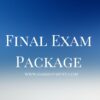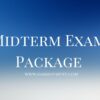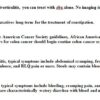Description
NR511 Final Exam Study Guide
NR 511 Week 1
- Define diagnostic reasoning
- Discuss and identify subjective & objective data
- Discuss and identify the components of the HPI
- Describe the differences between medical billing and medical coding
- Compare and contrast the 2 coding classification systems that are currently used in the US healthcare system
- Discuss how specificity, sensitivity & predictive value contribute to the usefulness of the diagnostic data
- Discuss the elements that need to be considered when developing a plan
- Describe the components of Medical Decision Making in E&M coding
- Correctly order the E&M office visit codes based on complexity from least to most complex
- Discuss a minimum of three purposes of the written history and physical in relation to the importance of documentation
- Accurately document why every procedure code must have a corresponding diagnosis code
- Correctly identify a patient as new or established given the historical information
- Identify the 3 components required in determining an outpatient, office visit E&M code
- Describe the components of Medical Decision Making in E&M coding
- Explain what a “well rounded” clinical experience means
- State the maximum number of hours that time can be spent “rounding” in a facility
- State 9 things that must be documented when inputting data into clinical encounter
- Identify and explain each part of the acronym SNAPPS
NR 511 Week 2
- Identify the most common type of pathogen responsible for acute gastroenteritis
- Recognize that assessing for prior antibiotic use is a critical part of the history in patients presenting with diarrhea
- Describe the difference between Irritable Bowel Disease (IBS) and Inflammatory Bowel Disorder (IBD)
- Discuss two common Inflammatory Bowel Diseases
- Discuss the diagnosis of diverticulitis, risk factors, and treatments
- Identify the significance of Barrett’s esophagus
- Discuss the diagnosis of GERD, risk factors, and treatments
- Discuss the differential diagnosis of acute abdominal pain, work-up and testing, treatments
- Discuss the difference between sensorineural and conductive hearing loss
- Identify the triad of symptoms associated with Meniere’s disease
- Identify the symptoms associated with peritonsilarabscess
- Identify the most common cause of viral pharyngitis
- Identify the most common cause of acute nausea & vomiting
- Discuss the importance of obtaining an abdominal xray to rule out perforation or obstruction even though the diagnosis of diverticulitis can be made clinically
- Discuss colon cancer screening recommendations relative to certain populations
- Identify at least two disorders that are considered to be disorders related to conductive hearing loss
- Identify the most common bacterial cause of pharyngitis
- Identify the clinical findings associated with mononucleosis
- Identify common characteristics in a rash caused be Group A Strep
- Discuss that the diagnosis of streptococcal pharyngitis can be made clinically based on the Centor criteria
- Describe an intervention for a patient with gastroenteritis
- Discuss an appropriate treatment for prophylaxis or treatment of traveler’s diarrhea
- Identify at least one effective treatment for Irritable Bowel Syndrome (IBS)
- Identify at least one prescription medication for the treatment of chronic constipation
- Discuss at least one treatment for Meniere’s disease
NR 511 Week 3
- Discuss that the majority of dyspnea complaints are due to cardiac or pulmonary decompensation
- Explain the differences between intra-thorax and extra-thorax flow disorders
- Identify at least three examples of flow and volume disorders (intra and/or extra thorax)
- Discuss diagnosis, risk factors and treatments for asthma
- Describe appropriate tests in the work up for dyspnea
- Discuss clinical findings and PFTs for asthma, chronic bronchitis, emphysema, and COPD
- Differentiate between the following common rashes: rubeola, rubella, varicella, roseola, 5ths disease, pityriasisrosea, hand, foot and mouth disease and molluscumcontagiosum.
- Differentiate between the following tineas: pedis, cruris, corporis and unguium and describe an appropriate treatment
- Identify the virus that causes warts
- Differentiate between atopic and contact dermatitis and give examples of each
- Identify common characteristics associated with blepharitis, chalzion and hordeolum
- Differentiate between viral, allergic, bacterial, toxic and HSV conjunctivitis
- Discuss which chemical injury is associated with the most damage and highest risk to vision loss
- Recognize common eye emergency conditions that require emergency room evaluation
- Discuss glaucoma, diagnosis and treatment
- Discuss diabetic retinopathy
NR 511 Week 5
- Identify the population most commonly affected by bacterial prostatitis
- Discuss the physical exam characteristics of acute bacterial prostatitis
- Discuss how the Phren sign can differentiate between testicular torsion and epididymitis
- Discuss common symptoms reported from a patient with BPH
- Discuss the hallmark characteristic of a varicocele
- Identify the population most affected by testicular cancer
- Explain spinal stenosis
- Discuss common characteristics (subjective and objective findings) of patients with lumbar spinal stenosis
- Identify the red flags associated with back and neck complaints which warrant further investigation
- Define chronic pain
- Identify the number of joints involved in a poly-articular disorder
- Describe the four cardinal signs of joint inflammation
- Differentiate between DeQuervain’s Tenosynovitis and Carpal Tunnel Syndrome
- Differentiate between lateral and medial epicondylitis
- Discuss at least 3 vital body functions which thyroid hormones regulate
- Describe a goiter and the type of thyroid dysfunction that can be associated with it
- Differentiate between overt hypothyroidism and subclinical hypothyroidism
- Differentiate between Hashimoto’s thyroiditis and Grave’s disease
- Identify at least 3 risks associated with obesity
- Identify at least 3 causes of obesity
- Discuss one primary prevention for obesity
- Identify the categories of obesity based on the BMI
- Discuss how acute low back pain without neurological dysfunction does not warrant radiological imaging
- Identify the roles of TSH, FT4, TT3, and TPO Abs in determining thyroid function
- Identify at least one “at-risk” population who should be considered for thyroid screening
- Discuss one physical characteristic seen in a hyperthyroid patient
- Identify the CDC recommended antibiotic class for treatment of acute bacterial prostatitis
- Identify at least one treatment for BPH
- Identify treatment options for obesity based on BMI and comorbid conditions
- Describe the Spurling test and what condition it is used to diagnose
- Describe how to perform a Phalen and Tinnel test
- Identify at least 3 physical exam maneuvers to assess the knee
- Diagnosing ACL injury: Lachman’s, anterior drawer test,
- Diagnosing meniscal tears: McMurray and Appley
- Diagnosing PCL injury: posterior drawer test and Thumb sign
- Diagnosing collateral (MCL and LCL) injury: Valgus and Varus stress test
NR 511 Week 6
- Differentiate between resting, postural and intention tremors and describe each
- Describe one disease with resting tremor as a clinical finding
- Describe a medication commonly associated with tremors
- Identify at least 3 laboratory tests to rule out systemic causes of tremor
- Describe at least one at-risk population that is recommended to have HIV screening
- Describe at least one pharmacologic treatment option for tremor
- Describe an appropriate empiric antibiotic treatment plan for cellulitis
- Discuss an intervention to prevent HIV and HIV-associated behaviors
- Identify physical exam findings in the patient with HIV
- Describe symptoms, DDx, pathogens, testing, and treatment for the following conditions: Cellulitis, impetigo, MRSA, Bites (dogs, cats, humans), Erysipelas






